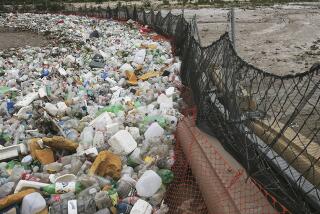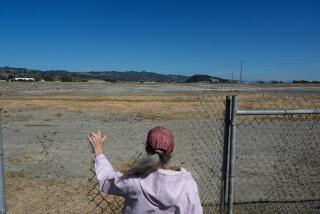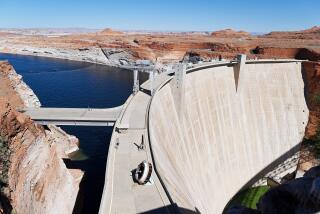Toxins, River on a Crash Course
- Share via
A blue-ribbon science committee warned Thursday that it is a “near certainty” that the Colorado River will someday run directly through a massive heap of uranium slag, raising the specter of massive radioactive contamination of the water source for 25 million people in California and the Southwest.
Although the slag heap is now about 750 feet from the river’s edge near Moab, Utah, rivers often “migrate,” and it is a “near certainty the river’s course will run across the Moab site at some time in the future,” according to a report by the National Research Council for the Department of Energy.
The scientific panel said it’s highly uncertain whether the migration of the river will take years or millenniums.
The department has responsibility for cleaning up the 12 million tons of uranium mill tailings and contaminated soil left from a uranium mill that shut down in 1984. The mill provided material for nuclear weapons.
Although the committee did not pick between the two leading alternatives--cover the heap or move the entire mess farther from the river--it called for more study and warned of the grave dangers of doing nothing.
Rep. Bob Filner (D-San Diego), one of several Western congressmen who have petitioned for the Bush administration to move the heap, said he was disappointed by the report from the National Research Council, chief operating arm of the National Academies.
“We need to move the site right now,” said Filner. “With all due respect to the National Academies, we know it is going to contaminate our drinking water someday. The time for studies is long past.”
In the final months of the Clinton administration, Department of Energy officials unveiled a plan to move the heap away from the river, an effort estimated to cost between $300 million and $1 billion. But the Bush administration put those plans on hold, pending further study.
The Moab site is the “newest, the largest and potentially the most expensive” of the uranium sites to be cleaned up by the government, according to the committee’s report.
The committee said it is unclear whether the Colorado River will move closer to the slag heap “over the coming millennia or in the next several decades.” If a decision is made not to move the heap, the committee concludes, the government should consider building barriers to keep the river from changing its course.
Adan Ortega, an executive with the Metropolitan Water District of Southern California, was more upbeat than Filner about the National Academies report. The MWD has lobbied Congress to have the heap moved away from the river, which provides more than half of the water that MWD supplies to 17 million people in six counties.
The report was required by legislation providing additional funding for cleaning up the site.
“This is a milestone,” Ortega said of the report. “Now that the study has been done, there is no excuse for not moving that mountain of uranium tailings.”
More to Read
Sign up for Essential California
The most important California stories and recommendations in your inbox every morning.
You may occasionally receive promotional content from the Los Angeles Times.










